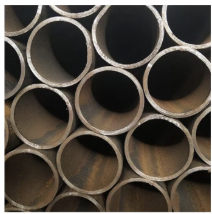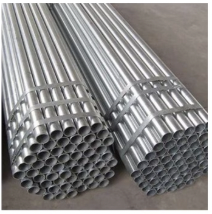بازیافتپذیری لولههای فولادی در ساختوساز دایرهای
سیستمهای حلقه بسته و بازیابی متریال
سیستمهای بستن حلقه در ساختوساز، فرآیندهایی هستند که پس از استفاده، مواد را به چرخه تولید بازمیگردانند یا از آن جدا میکنند تا از ضایعات و تولید مواد خام جدید جلوگیری شود. این موضوع بخش بسیار مهمی از ساختمانسازی سبز محسوب میشود. لولههای ساختهشده از فولاد میتوانند به دلیل استحکام و مقاومت بالایشان برای چنین سیستمهایی بهویژه مفید باشند. این لولهها قابل جداسازی از یک پروژه و استفاده مجدد در پروژه دیگری هستند که این امر باعث کاهش تولید فولاد جدید میشود. این نوع استفاده بهطور کامل اثرات منفی بر محیط زیست و منابع را کاهش میدهد. صنعت ساختوساز به عنوان مثال اکنون حدود ۹۸ درصد از تمام فولادهای سازهای را بازیافت میکند و پتانسیل مجدد استفاده از مواد را نشان میدهد. این نسبت بالای بازیافت عامل اصلی مهمی در پایداری و کاهش وابستگی به مواد خام جدید در درون صنعت است.
کاهش زبالههای ساخت و ساز از طریق بازیافت فولاد
بازیابی لولههای فولادی بازیافت از خرد کردن آسفالت یک روش ساده است که منجر به مزایای زیستمحیطی مختلف شده و به طور قابل توجهی باعث کاهش پسماندهای ساختمانی میگردد. تولید فولاد جدید با بازیافت فولاد مصرفشده، ذوب آن و شکلدهی مجدد به صورت محصولات فولادی نو. این فرآیند بازیافت انرژی بسیار کمتری نسبت به تولید فولاد جدید مصرف میکند و در نتیجه انتشار کربن را کاهش میدهد. در واقعیت، حدود ۷۰ درصد فولاد مصرفی در جهان بازیافت میشود که این امر به معنای کاهش عظیمی در حجم مواد زائد ساختمانی است که در غیر اینصورت در محلهای دفن زباله رها میشدند. سازمانهایی مانند مؤسسه بازیافت فولاد، مراحل مشخصی از بازیافت فولاد را توصیه میکنند تا فرآیند ایدهآل بازیافت تسهیل شود. این موارد ثابت کردهاند که بازیافت نه تنها برای محیط زیست مفید است، بلکه از نظر اقتصادی نیز سودآور است و در نتیجه تعداد بیشتری از کارخانهها این روش را دنبال میکنند.
تحلیل چرخه زندگی فولاد نسبت به مواد سنتی
مقایسه چرخه حیات هنگام مقایسه تحلیلهای چرخه حیات، لوله فولادی مزایای بسیاری نسبت به مواد متداولی مانند چوب یا بتن دارد. فولاد ردپای کربنی کمتری دارد زیرا قابل بازیافت است و با کورههای قوس الکتریکی که از فولاد بازیافتی شروع کرده و محصولات جدیدی تولید میکنند، به شیوهای کارآمدتر تولید میشود. سازههای فولادی به منابع و نگهداری کمتری نیاز دارند و در مقایسه با سایر انواع زیرساختهای بلندمدت، عمر طولانیتری دارند. نظر متخصصان سازمانهای پیشرو محیط زیست این است که مزایای چرخه حیات فولاد منجر به تمایل فزاینده به این ماده در ساختوساز پایدار میشود؛ نرخ بازیافت فولاد میتواند در طول چرخه حیات، مصرف انرژی را در مقایسه با چوب یا بتن کاهش دهد. و نه در آخر، استدلال پایداری همچنین نشان میدهد که فولاد میتواند تا ۷۵٪ در کاهش ردپای کربن یک ساختمان در طول چرخه حیات آن کمک کند و آن را به یک عامل کلیدی در استانداردهای ساختمان سبز تبدیل کند.
برتری باربری و کارایی مادی
مزایای نسبت قدرت به وزن بالا
نسبت استحکام به وزن در ساختوساز بسیار مهم است، زیرا این نسبت رابطه بین استحکام، وزن و هزینه ماده را نشان میدهد و مشخص میکند که آیا ماده از نظر ظاهری سنگین است یا خیر. لولههای فولادی در این زمینه نمونه بارزی هستند؛ زیرا ظرفیت باربری بسیار خوبی دارند و به همین دلیل میتوان از آنها در پیکربندیهای ساختاری نوآورانهتر و مقرونبهصرفهتر استفاده کرد. این لولهها نه تنها به ازای هر واحد وزن سختتر هستند، بلکه میتوانند هزینههای ساختاری را بهطور چشمگیری کاهش دهند. یک مثال کلاسیک، طراحی لولههای فولادی برای سازههای بلند است که در آن معماران از ویژگیهای برتر نسبت استحکام به وزن فولاد بهره بردهاند تا طرحهای پیشرفتهای را به واقعیت تبدیل کنند که در عمل پابرجا بمانند.
کاهش حداقل نیازهای بنیاد در ساختمانهای سبز
لولههای فولادی جزء ضروری در کاهش ابعاد پیها هستند که هدفی مهم در طراحی ساختمانهای سبز محسوب میشود، زیرا با کوچکتر کردن منطقه ساخت پی، از آشفتگی یا جابهجایی مناطق اطراف جلوگیری میکنند. با استفاده از لولههای فولادی، توسعهدهندگان میتوانند پیهای کوچکتر و سبکتری ایجاد کنند که باعث کاهش آشفتگی در محل پروژه و بهبود حفاظت از محیط زیست میشوند. به عنوان مثال، طراحی اصلی شبکهای آهنی برج ایفل، الهامبخش نسخههای معاصرتری از لولههای فولادی با پیهای کوچکتر بوده است. این سازههای کوچکتر که همچنان تحملپذیر هستند، به حفظ اکوسیستمهای طبیعی و کاهش تقاضای مصرف منابع کمک میکنند که هر دو از اهداف مهم ساختمانسازی پایدار محسوب میشوند.
نقش در ساخت ماژولی و پیش ساخته
فولاد (لولهای) همچنین دوستی برای ساختوساز ماژولار و پیشساخته است و به سرعت بیشتر (و در برخی موارد، کارایی بیشتر) در اجرای ساختمانها کمک میکند. با توجه به نسبت استحکام به وزن برجسته و نصب آسان آنها، لولههای فولادی انتخاب اولیه در نصبهای پیشساخته نیز هستند. با افزایش تقاضا برای ساختوساز سریع و فوری، استفاده از لولههای فولادی پیشبینی میشود. ابتکاراتی مانند ساخت سریع آسمانخراشهای شرکت Broad Sustainable Building نشان میدهد که چارچوبهای لولهای فولادی چقدر میتوانند زمان برنامههای ساخت را کاهش دهند، بدون آنکه به کیفیت یا معیارهای سبزشدن آسیب برسانند. با توسعه صنعت پیشساخته، انعطافپذیری و استحکام لولههای فولادی به خوبی میتواند نیازهای ساختمانی آینده را برآورده کند.
طول عمر بیشتر و کاهش اثرات زیست محیطی
DAYNATY در برابر آب و هوای سخت و مقاومت علیه خوردگی
لولههای فولادی مقاوم در برابر خوردگی، عملکرد عالی در شرایط آب و هوایی مختلف دارند. لولههای فولادی به بودن یکپارچگی ساختاری علیرغم شرایط اقلیمی و خطرناک، مدیون نوآوریهایی مانند جوشکاری مقاومت الکتریکی و نورد بدون درز هستند. این ویژگیها مقاومت عالی در برابر خوردگی و استحکام بالا را فراهم میکنند. به عنوان مثال، مجله علم مهندسی مطالعهای منتشر کرده است که نشان میدهد لولههای فولادی در شرایط اقلیمی شدید، عمر طولانیتری نسبت به گزینههای معمولی دارند و در بلندمدت صرفهجویی در هزینه را به همراه میآورند. این دوام، جایگزینی بلندمدت و اقتصادی را در مقایسه با سایر مواد مانند پلاستیک و چوب ارائه میدهد و از آنجا که لولههای فولادی به راحتی قابل بازیافت هستند، یکی از گزینههای برتر برای پروژههایی هستند که نیازمند مواد مقاوم در برابر مواجهه طولانیمدت با عوامل محیطی میباشند.
نیازهای نگهداری کمتر در طول عمر ساختمانها
لولههای فولادی بهمراتب بیشتر با نیازهای کمنگهداری سازگار هستند و این امر منجر به صرفهجویی مالی در طول عمر سازه میشود. با کاهش سایش، لولههای فولادی به تعمیرات و تعویضهای کمتری نیاز دارند و در نتیجه زمان توقف و هزینههای نگهداری کاهش مییابد. نظرات متخصصان نشان میدهد که ساختمانهای فولادی تا ۴۰ درصد کاهش در هزینههای نگهداری و چرخه عمر تا ۵۰ سال دارند که به اقتصاد بلندمدت ساختوساز نسبت داده میشود. (UA) لولههای فولادی توسط صنعت بهدلیل نیاز حداقلی به نگهداری توصیه میشوند که این امر به ذینفعان اجازه میدهد تا از منابع موجود به شیوهای کارآمد استفاده کنند و در نتیجه امکانپذیری اقتصادی ساختوساز را بهبود بخشند.
Besparingen op levenscycluskosten voor duurzame projecten
استفاده از لولههای فولادی در پروژههای ساختوساز میتواند صرفهجویی قابل توجهی در هزینههای کل عمر مفید به همراه داشته باشد. اگرچه هزینه اولیه آن ممکن است بیشتر از سایر مواد باشد، اما لولههای فولادی نه تنها عمر طولانیتری نسبت به اکثر پلاستیکها دارند، بلکه نیاز بسیار کمی به نگهداری دارند و در نتیجه در بلندمدت صرفهجویی بزرگی را فراهم میکنند. مطالعات نشان میدهند که توسعهدهندگانی که به نفع استفاده از کانالهای فولادی تصمیم میگیرند، از راهحلهای صرفهجویی در چرخه عمر کلی، هزینههای نگهداری پایین و تأثیر زیستمحیطی کم بهرهمند میشوند - عواملی ضروری برای پروژههای پایدار. شواهد شرکتهای بزرگ ساختوساز، تأثیر مثبت مدل ارزیابی هزینه چرخه عمر با مزایای بلندمدت آن را بر بودجه پروژهها و تحقق اهداف توسعه پایدار نشان میدهد.
لولههای فولادی در انرژی تجدیدپذیر و زیرساخت هوشمند
برجهای توربین باد و چارچوب پنلهای خورشیدی
لولههای فولادی ساختاری در ساخت برج توربین بادی و سازههای صفحه خورشیدی اهمیت بالایی دارند. این لولهها به طور طبیعی مقاوم و بادوام هستند و برای تحمل وزن پرههای سنگین توربین بادی و محافظت در برابر شرایط آب و هوایی شدید طراحی شدهاند. در بسیاری از پروژههای موفق انرژی تجدیدپذیر، افزایش کارایی از طریق استفاده از لولههای فولادی به روشی رایج تبدیل شده است. به عنوان مثال، مزرعه بادی محبوب Horns Rev در دانمارک بیش از 17 سال خدمات خوبی از توربینهای فراساحلی را ارائه کرده است که بر روی برجهای لولهای فولادی با دوام و قابل اعتماد نصب شدهاند و توان بالایی تولید میکنند. استفاده از لولههای فولادی نه تنها به ترویج منابع انرژی پاک کمک میکند، بلکه عمر عملیاتی تجهیزات مربوطه را نیز افزایش میدهد.
کاربردها در سیستمهای HVAC با کارایی انرژی
در واحدهای تهویه مطبوع با کارایی انرژی، لولههای فولادی به دلیل هدایت حرارتی خود بخش مهمی از لولهها و مجاری تهویه مطبوع محسوب میشوند. این لولهها انتقال موثر گرما را فراهم میکنند که منجر به مصرف کمتر انرژی و عملکرد بهتر کل سیستم میشود. تحقیقات نشان داده است که استفاده از لولههای فولادی در سیستمهای تهویه مطبوع میتواند تا ۳۰٪ انرژی را صرفهجویی کند. این کارایی از اهمیت بالایی برخوردار است، زیرا شرکتها و افراد در تلاش هستند تا تأثیرات منفی خود بر طبیعت را کاهش دهند. بهکارگیری این سیستمها هزینههای عملیاتی را کاهش میدهد و از نظر محیطزیستی نیز دوستداشتنی است؛ بنابراین هم برای سودآوری و هم برای محیطزیست مزیت دوگانهای ایجاد میکند.
پشتیبانی از شبکههای حملونقل شهرهای هوشمند
لولههای فولادی پایههای اصلی شبکههای حمل و نقل شهرهای هوشمند محسوب میشوند و به دلیل دوام و یکپارچگی ساختاریشان مورد ارزشگذاری قرار میگیرند. این لولهها در ساخت سیستمهای ریلی، پلها و تونلهایی به کار میروند که باید برای سالها و سالها در برابر نیروهای طبیعی یا انسانی مقاومت کنند و آسیب نبینند. لولههای فولادی برای بهبود تحرک محلی و جهانی پروژههای شهری به طور فزایندهای از لولههای فولادی برای بهروزرسانی زیرساختها استفاده میکنند. به عنوان مثال، ابتکار شبکه حمل و نقل هوشمند تحتنظارت شهر سنگاپور، با معرفی لولههای فولادی دارای ساختار خطی، دوام را افزایش داده و نیازهای تعمیر و نگهداری را کاهش داده است تا ایمنی جادهها تضمین شود. این نوآوریها به شهرها کمک میکنند تا به سمت توسعه شهری پایدار و هوشمند حرکت کنند و حمل و نقل را برای همه و برای نسلهای آینده کارآمدتر و ایمنتر سازند.

نوآوری در حوزه پایداری لوله فولادی تولید
ساخت فولاد مبتنی بر هیدروژن برای کاهش کربن
تولید فولاد با هیدروژن با امکان کاهش قابل توجه کربن، صنعت فولاد را دگرگون میکند. این روش انقلابی، روشهای کلاسیکِ حاوی کربن مانند کورههای قوس الکتریکی سوختدهیشده با کک را با منبعی بدون دیاکسید کربن جایگزین میکند و انتشار دیاکسید کربن را کاهش میدهد. برخی از کاربردهای فعلی در صنعت شامل شرکتهای بزرگ فولادسازی اروپایی مانند آرسلورمیتال و تیسنکروپ هستند که درهایی به سوی تولید فولاد سبزتر گشودهاند. تحقیقات جدید به مزایای زیستمحیطی این روش اشاره دارند و کاهش تا ۹۰ درصدی ردپای کربن را نشان میدهند که گامی بزرگ به سوی تولید پایدار است.
فناوریهای جمعآوری کربن در تولید
فناوریهای جذب کربن به تدریج در فرآیند تولید فولاد معرفی شدهاند و فرصتهای قابل توجهی برای کاهش انتشارات فراهم کردهاند. این فناوریها انتشار دیاکسید کربن حاصل از تولید فولاد را جمعآوری و ذخیره میکنند، به جای آنکه اجازه دهند به جو آزاد شوند. و ذخیرهسازی میتواند مؤثر باشد — اگر این اقدام را در قالب افزودن پروژههای عظیم مهندسی به زیرساخت موجود خود در نظر بگیریم — که میتواند منجر به کاهش ۳۰ درصدی انتشارات شود؛ بر اساس یافتههای آژانس بینالمللی انرژی (IEA)، اجرای این فناوری برای مبارزه با چالش آبوهوایی ضروری است. این سطح از اثربخشی به تدریج در حال تغییر نحوه تفکر کلیه بخشها درباره پایداری است، متناسب با اهداف جهانی برای دستیابی به صفر آلایندگی.
آلیاژهای سبک که عملکرد زیستمحیطی را افزایش میدهند
این آلیاژ سبکوزن که با لوله فولادی ترکیب شده است، عملکرد زیستمحیطی را در تعدادی از کاربردها بهبود میبخشد. این آلیاژها به کاهش وزن سازهها کمک میکنند و در عین حال استحکام و دوام سازه حفظ میشود. همچنین در بخش ساختمان، این آلیاژها در حال کمک به هموار کردن راه برای طراحیهای نوآورانه و پایدار در ساختمانسازی هستند. متخصصان پیشبینی میکنند که ترکیب با آلیاژهای سبکوزن منجر به کاهش مصرف انرژی تا حدود ۲۰ درصد در سازهها خواهد شد و بدین ترتیب ساختوساز دوستدار محیط زیست ترویج مییابد. گفتوگوهای انجامشده با چهرههای پیشرو در صنعت نیز بیش از پیش بر اشتیاق قابل توجه نسبت به پتانسیل این آلیاژها در هدایت نوآوریهای سازگار با محیط زیست در آینده تأکید میکنند.
سوالات متداول
چرا لولههای فولادی در ساخت و ساز پایدار تلقی میشوند؟ لولههای فولادی به دلیل قابلیت بازیافتپذیری، استحکام و نیازمندی انرژی کمتر در طی تولید، پایدار تلقی میشوند. این ویژگیها کمک میکنند تا اmissão کربن و تأثیرات زیستمحیطی کاهش یابد.
نقش لولههای فولادی در روشهای ساخت سبز چیست؟ لولههای فولادی به روشهای ساخت سبز کمک میکنند توسط کاهش اندازه بنیادها، افزایش ساخت ماژولی و کاهش زبالههای ساخت، که همه آنها به کاهش نگرش محیط زیستی کمک میکند.
چگونه بازیابی لولههای فولادی به محیط زیست کمک میکند؟ بازیابی لولههای فولادی با کاهش مصرف انرژی، کاهش گازهای گلخانهای و جلوگیری از تجمع زباله در دامپها به محیط زیست کمک میکند.
آیا لولههای فولادی میتوانند در پروژههای انرژی تجدیدپذیر استفاده شوند؟ بله، لولههای فولادی در پروژههای انرژی تجدیدپذیر نقش مهمی دارند، به ویژه در برجهای توربین باد و چارچوب پنلهای خورشیدی، به علت قوی بودن و طول عمر بلند آنها.

